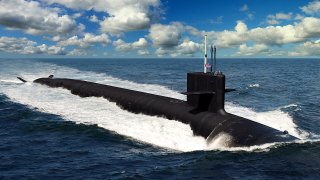Columbia-Class: The Navy's $346 Billion Missile Submarines Have a Problem
The U.S. Navy's Columbia-class nuclear-powered ballistic missile submarines, set to replace the Ohio-class, face delays due to supplier issues, pushing the delivery of the lead vessel, USS District of Columbia (SSBN-826), to Fiscal Year 2028.
Summary: The U.S. Navy's Columbia-class nuclear-powered ballistic missile submarines, set to replace the Ohio-class, face delays due to supplier issues, pushing the delivery of the lead vessel, USS District of Columbia (SSBN-826), to Fiscal Year 2028. Challenges include delays in the construction of the bow module at Huntington Ingalls Industries in Virginia and steam turbines by Northrop Grumman. The program, crucial for the U.S. strategic deterrent mission, is one of the Pentagon's most expensive, with an estimated total lifecycle cost of $347 billion. These submarines, the largest ever built by the U.S., feature advanced technology and a life-of-ship reactor.
Behind Schedule: Challenges Rock the Columbia-Class Submarine Program
The United States Navy's future Columbia-class nuclear-powered ballistic missile submarines – which are set to replace the aging Ohio-class boats – could arrive later than expected according to reports that circulated late Monday. According to the Capitol Forum, the U.S. Navy is now forecasting at least a year-long delay to the acquisition program due to supplier problems.
USNI News further reported that the lead boat of the program is facing a delay due to supplier issues, and as a result, the future USS District of Columbia (SSBN-826) could be delivered in Fiscal year 2028 (FY28) instead of the previously planned FY27 delivery.
The largest hurdle is the lead boat's bow module, which is now under construction at Huntington Ingall Industry's Newport News Shipbuilding in Virginia and is far behind schedule. Moreover, the entire program is further facing delays from the steam turbines that Northrop Grumman is building for the U.S. Navy.
HII has been late in delivering other sections of the boat, which has delayed the timeline for the construction of SSBN-826.
"We're seeing stress across the industrial base and again I think putting this in the context of the Secretary's 45-day review will add additional depth and context to the challenges that we’re seeing across the shipbuilding portfolio and we expect to have that done fairly soon," Under Secretary Erik Raven told USNI News following the U.S. Navy's Fiscal Year 2025 budget briefing on Monday.
Replacing the Ohio-class
Originally known as the Ohio Replacement Program (ORP) or SSBN(X), until 2016, it called for replacing the Ohio-class subs with the new Columbia -class SSBNs beginning in the early 2030s.
The program's goal is to build a dozen of the new nuclear-powered submarines, and those boats will continue to support the U.S. strategic deterrent mission.
However, the program now appears to be running behind schedule, and the U.S. Navy may be forced to keep the Ohio-class subs in service longer than expected. The original plan called for the first of the SSBNs to be retired beginning in 2027, with an additional boat leaving the service every year until 2040. The Navy has already determined it would be possible to extend the service life of at least five of its Ohio-class subs by two to three years each so that the force would remain at 12 vessels or more for all but three years between 2024 and 2053.
Expensive Program
Even before the delays were announced – which could raise the price tag – the Columbia -class SSBNs were on track to be one of the most expensive Pentagon programs. It was previously reported that the U.S. Navy would spend around $132 billion for the procurement of the dozen submarines, while the total lifecycle cost for the entire class is estimated at $347 billion.
That figure includes all projected costs to develop, buy, and operate the 12 submarines through 2042.
In its Fiscal Year 2019 (FY19) request, Navy officials asked for $3.7 billion for the Columbia-class program – a 97% increase over 2018, making it the second-most expensive program in the 2019 Pentagon budget request, next to the Lockheed Martin F-35 Joint Strike Fighter, which is operated by the U.S. Air Force, U.S. Navy and U.S. Marine Corps.
Last October, a Congressional Budget Office (CBO) warned that the program risks running at least 20% over, or about $20 billion, due to potential delays.
Large and In Charge
The new SSBNs will be the largest submarines ever built by the United States. Each of the planned dozen boats will be 560 feet in length and have a beam of 43 feet.
The Columbia-class will be equipped with sixteen SLBM tubes, as opposed to twenty-four SLBM tubes on Ohio-class SSBNs. That will also reduce construction, operations, and maintenance costs. In addition, the new boats will utilize the joint American-British developed Common Missile Compartment (CMC), which will also be installed on the Royal Navy's new Dreadnought-class submarines. It was designed to launch the Trident II D5 intercontinental ballistic missile (ICBM). The joint effort has been reported to save each nation hundreds of millions of dollars.
The new submarines will be longer, heavier, and feature a complex electric drive propulsion system and associated technology.
Unlike the preceding Ohio-class, the new ballistic missile submarines are being constructed with a life-of-ship reactor, which will result in a shorter mid-life maintenance period, and each was designed to serve a 42-year service life.
Author Experience and Expertise: Peter Suciu
Peter Suciu is a Michigan-based writer. He has contributed to more than four dozen magazines, newspapers, and websites with over 3,200 published pieces over a twenty-year career in journalism. He regularly writes about military hardware, firearms history, cybersecurity, politics, and international affairs. Peter is also a Contributing Writer for Forbes and Clearance Jobs. You can follow him on Twitter: @PeterSuciu. You can email the author: [email protected].


